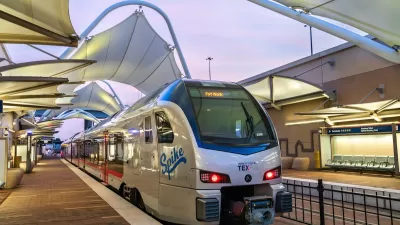Public transport is overall very safe (low crash rate) and secure (low crime rate). However, experts seldom promote transit as a traffic safety strategy, and advocates seldom emphasize safety as a transit benefit. It's time for a new narrative.

Research described in a new article published in the Journal of Public Transportation, "A New Transit Safety Narrative," indicates that increased transit travel and more transit-oriented development can provide significant traffic safety and crime reduction benefits. These benefits are potentially large, but generally overlooked by safety experts and transit advocates.
Transit travel has less than a tenth the crash casualty rate as automobile travel, and transit-oriented development residents experience less than a fifth of the traffic casualty rate, per capita, as automobile-oriented communities. In addition, per capita crime rates tend to be lower in more compact, mixed, transit-oriented neighborhoods, and all else being equal, tend to be lower in more transit-oriented cities than in automobile-dependent cities. This research supports Jane Jacob's hypothesis that more compact, mixed development tends to reduce crime by increasing passive surveillance ("eyes on the street") by responsible (non-criminal) people who live, work, and walk in an area.
Despite these benefits, many people fear transit, experts seldom promote transit as a traffic safety strategy, and transit advocates seldom emphasize safety as a significant benefit of pro-transit policies. Various factors contribute to the under-appreciation of transit safety benefits including the nature of transit travel, dramatic news coverage of transit crashes and crimes, transit agency messages that unintentionally emphasize risks without providing information on its overall safety, and biased traffic safety analysis.
There is significant potential for changing perceptions. We now have credible evidence that public transit is relatively safe and secure, and pro-transit policies can further reduce risks. Planning is becoming more multi-modal and there is increasing recognition that pro-transit policies are justified to achieve various planning objectives. There is growing demand for transit travel and transit-oriented development. A few traffic safety programs already recognize the safety benefits of pro-transit policies. This suggests that many people may be receptive to new messages about transit safety benefits.
Transportation professionals can create a new, more accurate and positive transit safety narrative which emphasizes that transit is overall very safe, communicates the safety impacts of pro-transit policies, addresses common misperceptions about transit risks, and provides practical guidance on how to further reduce transit risks. Although rational arguments alone may not change everybody’s beliefs about transit safety, such information should be part of overall marketing programs that help reposition transit as an efficient, attractive, enjoyable and prestigious form of travel that benefits people and communities.
FULL STORY: A New Transit Safety Narrative

Manufactured Crisis: Losing the Nation’s Largest Source of Unsubsidized Affordable Housing
Manufactured housing communities have long been an affordable housing option for millions of people living in the U.S., but that affordability is disappearing rapidly. How did we get here?

Americans May Be Stuck — But Why?
Americans are moving a lot less than they once did, and that is a problem. While Yoni Applebaum, in his highly-publicized article Stuck, gets the reasons badly wrong, it's still important to ask: why are we moving so much less than before?

Using Old Oil and Gas Wells for Green Energy Storage
Penn State researchers have found that repurposing abandoned oil and gas wells for geothermal-assisted compressed-air energy storage can boost efficiency, reduce environmental risks, and support clean energy and job transitions.

Greening Oakland’s School Grounds
With help from community partners like the Trust for Public Land, Oakland Unified School District is turning barren, asphalt-covered schoolyards into vibrant, green spaces that support outdoor learning, play, and student well-being.

California Governor Suspends CEQA Reviews for Utilities in Fire Areas
Utility restoration efforts in areas affected by the January wildfires in Los Angeles will be exempt from environmental regulations to speed up the rebuilding of essential infrastructure.

Native American Communities Prepare to Lead on Environmental Stewardship
In the face of federal threats to public lands and conservation efforts, indigenous groups continue to model nature-centered conservation efforts.
Urban Design for Planners 1: Software Tools
This six-course series explores essential urban design concepts using open source software and equips planners with the tools they need to participate fully in the urban design process.
Planning for Universal Design
Learn the tools for implementing Universal Design in planning regulations.
Heyer Gruel & Associates PA
City of Moreno Valley
Institute for Housing and Urban Development Studies (IHS)
City of Grandview
Harvard GSD Executive Education
Salt Lake City
NYU Wagner Graduate School of Public Service
City of Cambridge, Maryland





























